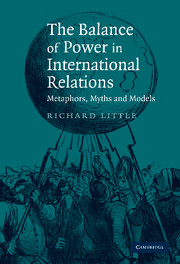3 - The balance of power: from metaphors to myths and models
Published online by Cambridge University Press: 05 October 2014
Summary
In the previous chapter I argue that metaphors are not only a surprisingly complex phenomenon but also that any assessment of the balance of power is profoundly affected by whether we regard the concept as a substitution or an interaction metaphor. If we treat the balance of power as an interaction metaphor, then the effect is to reconstitute the meaning of power and we move from an agency-based concept to a structurally based concept and I suggest that a set of weighing scales provides a generic metaphorical source that promotes this conceptual transformation. The ubiquitous use made of the generic balance of power reveals that the transformation is an easy and uncontroversial step to take. However, despite the promiscuous use that is made of the generic source, it has proved insufficient to elevate the balance of power into a key concept across the social sciences. Only in the area of international politics has the balance of power come to be regarded as a central or indispensable concept. Yet, ironically, international politics is also the only area where the concept is regarded as highly contentious.
The aim of this chapter, therefore, is to account for the centrality and significance of the balance of power in the theory and practice of international politics as well as the controversy that surrounds the concept.
- Type
- Chapter
- Information
- The Balance of Power in International RelationsMetaphors, Myths and Models, pp. 50 - 88Publisher: Cambridge University PressPrint publication year: 2007



